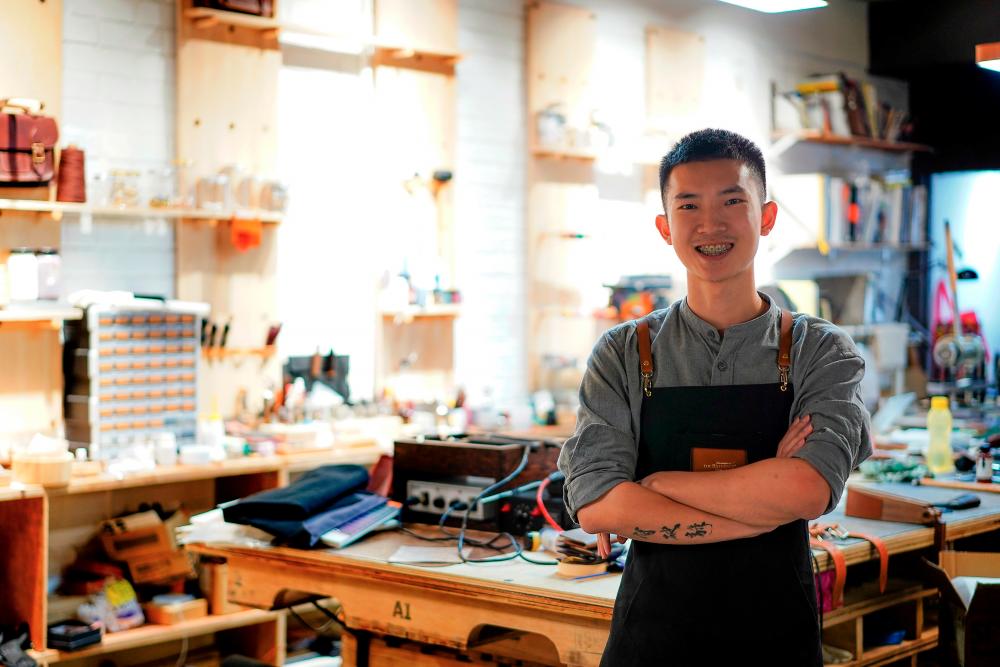GRAPHIC DESIGNER turned leather craftsman Zi Xian co-founded local leather goods brand Tyde with his partner Joyce Aw to bring their shared passion to life, focusing on the quality of leather and innovation in meeting the demands of their clientele.
For the past three years, the self-taught craftsman has steered his craft explicitly towards leather goods such as bags, wallets, purses, belts and the like by combining the different processes, textures, finishes and colours to enable his customers to express themselves through Tyde’s bespoke services.
He treats the art of leather crafting with the respect it deserves, even taking up to three months to perfect a single leather bag, utilising his exceptional skills and paying attention to the smallest detail.
What made you pursue leathercraft?
“Despite the shift, I still consider crafting leather goods as an art similar to graphic designing.
“It all started back in college, where we were challenged to explore the different types of material including papers, tactile fabrics and even metal to create a publication for our final year project, in which I discovered how interesting leather is to work with.
“After completing the project, I continued to find the process of crafting something entirely from scratch to be really fun and exciting, so I started making small leather goods as gifts for friends and family.”
What is it about leather that really intrigues you?
“Leather has really interesting textures, and as a material, it is long-lasting and durable. I see it as a canvas that can be transformed into basically anything. There are so many ways to work with it and its potential is limitless, I’ve still yet to explore all of it, which is really exciting to me.”
Is your graphic design background complementary or a challenge to the creative process?
“Definitely complementary. Tyde offers a bespoke service, which is basically designing a custom-made product to a person’s liking from scratch.
Every customer has an individual request and [specific idea in mind], from a very particular colour of choice, to shape and size, to the different types of leather to choose from, and even other personalisation effects like stamping and embossing.
“Custom-made products like these need to go through [different] stages of design including digital sketching, mock-ups and prototypes.
“Having studied graphic design, I’m able to use software to create mock-ups before handcrafting the product.”
Is it difficult to introduce the idea of artisanal craft, when we’re used to seeing commercial goods made available through mass production?
“It’s been a tough journey putting up against mass-produced commercial goods because [their] values are not in line with what we stand for here at Tyde. Since the beginning, we’re constantly educating our audience about the values of artisanal craft, through the art of bespoke leather goods.”
How do you judge the quality of leather?
“There are many criteria to define what makes a good quality leather good. As seen in many ready-made products, after a couple of years, [they will] start to peel, crack and even distort.
“Hence, the better the quality of the leather, the stronger the fibre and the more lasting the product is. A good quality leather good can typically last up to 20 years.”
Sustainability and ethical leather sources are becoming keywords in your industry. How are you engaging and contributing to this conversation?
“[Exotic] leather farming is strictly controlled by the authorities to ensure that it is well-regulated and sustainably sourced.
“Every single exotic leather [skin] that we’ve legally acquired is licensed and certified with an individual tracking code that can be traced back to its original source.
“Just like in Africa – where ostriches are farmed for their feathers, meat and skin so nothing goes to waste – it is very much similar to getting cow leather.”
Is it harder to work with exotic leather than cow leather?
“Working with cow leather doesn’t require much reinforcement material, but when it comes to alligator, ostrich or lizard leather, their skin properties and texture are so much different.
“It requires a different set of skills and knowledge to work with these exotic leathers in order to achieve a stable and more reinforced structure.”









